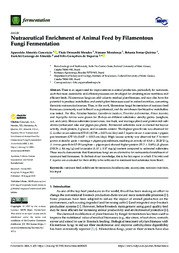Nutraceutical enrichment of animal feed by filamentous fungi fermentation.
Nutraceutical enrichment of animal feed by filamentous fungi fermentation.
Author(s): CONCEIÇÃO, A. A.; MENDES, T. D.; MENDONCA, S.; QUIRINO, B. F.; ALMEIDA, E. G. de A.; SIQUEIRA, F. G. de
Summary: There is an urgent need for improvements in animal production, particularly for ruminants, such that more sustainable and efficient processes are developed for obtaining more nutritious and efficient feeds. Filamentous fungi can add value to residual plant biomass, and may also have the potential to produce metabolites and enrich plant biomasses used in animal nutrition, converting them into nutraceutical sources. Thus, in this work, filamentous fungal fermentation of ruminant feed biomasses commonly used in Brazil was performed, and the enrichment for bioactive metabolites was tested. For this, Fistulina hepatica, Ganoderma lucidum, Pleurotus pulmonarius, Panus lecomtei, and Aspergillus terreus were grown for 28 days on different substrates: starchy grains- (sorghum, oat, and corn), fibrous substrates (coast-cross, rice husk, and moringa plant) and protein-rich substrates (cottonseed cake and pigeon pea plant). Fermented substrates were evaluated for laccase activity, crude protein, -glucan, and lovastatin content.
Publication year: 2022
Types of publication: Journal article
Unit: Embrapa Agroenergy
Keywords: Ascomycete, Basidiomycete, Bio-input, Fermentation, Ruminant nutrition, Ruminants
Observation
Some of Embrapa's publications are published as ePub files. To read them, use or download one of the following free software options to your computer or mobile device. Android: Google Play Books; IOS: iBooks; Windows and Linux: Calibre.
Access other publications
Access the Agricultural Research Database (BDPA) to consult Embrapa's full library collection and records.
Visit Embrapa Bookstore to purchase books and other publications sold by Embrapa.

